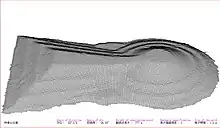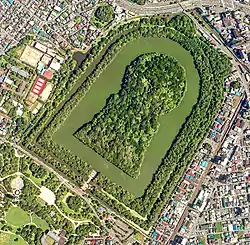| Furuichi kofungun | |
|---|---|
 Kondagobyōyama Kofun. This is the largest in the group. | |
| Details | |
| Location | |
| Coordinates | 34°33′46″N 135°36′33″E / 34.56278°N 135.60917°E |
| Official name | Mozu-Furuichi Kofun Group: Mounded Tombs of Ancient Japan |
| Criteria | Cultural: (iii), (iv) |
| Designated | 2019 (43rd session) |
| Reference no. | 1593 |
| Region | Eastern Asia |


Furuichi kofungun (古市古墳群) is a group of Kofun period burial mounds located in the cities of Fujiidera and Habikino, Osaka Prefecture, Japan.[1] Twelve of the tumuli in this group were individually designated a National Historic Site of Japan in 1956, within additional 14 collectively added to the designation in 2001, and the area under protection expanded in 2018.[2][3]
Overview
The Furuichi Kofun Cluster extends over an area of 2.5 kilometers north-to-south by four kilometers east-to-west, covering plateaus and hill with an average elevation of 24 meters above sea level. These tumuli were built between the late 4th and the mid-sixth century AD. Twenty-seven, including many of the larger tumuli, are under the control of the Imperial Household Agency and are classified as "imperial tombs", for which archaeological excavation has been prohibited.
In 2010 the Furuichi kofungun cluster of tumuli, along with those of Mozu kofungun, were proposed for inscription on the UNESCO World Heritage List.[4] On 6 July 2019, Mozu-Furuichi Kofun Group was inscribed as a UNESCO World Heritage Site under Criteria: (iii), (iv).[5]
Decline of The Mozu-Furuichi Kofun Group
After the Ichinoyama Kofun, the era of grand tomb groups began to decline. Though a few large tombs were still erected, like the Okamisanzai Kofun, the frequency and size began to diminish. The Kawachi Otsukayama Kofun is an outlier, situated between the Mozu and Furuichi Kofun Groups, was built, measuring a staggering 355 meters in length. Its construction during this period remains a mystery, calling for further research and analysis.[6]
As the Furuichi Kofun Group progressed past its prime, the center of tomb construction transitioned to locations such as Shinagadani (also referred to as Kawachi-Asuka), near present-day Taishi Town. The primary locus for tombs in the Kawachi region shifted from Mozu and Furuichi to areas like Shinaga.[6]
Types
- zenpō-kōen-fun (前方後円墳) ("keyhole-shaped) : formerly 31, 26 survive
- empun (円墳) ("circular"): formerly 30, 5 survive
- hōfun (方墳) ("square"): formerly 48, 22 survive
- indeterminate: formerly 14, 34 survive
Total: formerly 123, 87 survive
Gallery
 Kondagobyoyama Kofun
Kondagobyoyama Kofun Hakayama Kofun
Hakayama Kofun Okamisanzai Kofun
Okamisanzai Kofun Karusato Otsuka Kofun
Karusato Otsuka Kofun
| Name | Name | Type | Length | National Historic Site | Imperial Household Agency | World Heritage Site & Comments |
|---|---|---|---|---|---|---|
| Kondayama Kofun | 誉田御廟山古墳(誉田山古墳) | keyhole | 425m | NHS | Emperor Ojin | WHS |
| Nakatsuyama Kofun | 仲ツ山古墳(仲津山古墳) | keyhole | 290m | NHS | Nakatsu-hime | WHS |
| Okamisanzai Kofun | 岡ミサンザイ古墳 | keyhole | 242m | Emperor Chūai | WHS | |
| Ichinoyama Kofun | 市ノ山古墳(市野山古墳) | keyhole | 230m | Emperor Ingyō | WHS | |
| Hakayama Kofun | 墓山古墳 | keyhole | 225m | NHS | Emperor Ōjin baichō | WHS |
| Tsudoshiroyama Kofun | 津堂城山古墳 | keyhole | 210m | NHS | Fujiidera Tomb Reference Site | WHS |
| Karusato Ozuka Kofun | 軽里大塚古墳(前の山古墳/白鳥陵古墳) | keyhole | 200m | NHS | Yamato Takeru | WHS |
| Nonakamiyayama Kofun | 野中宮山古墳 | keyhole | 154m | |||
| Komuroyama Kofun | 古室山古墳 | keyhole | 150m | NHS | WHS | |
| Nonaka Bokeyama Kofun | 野中ボケ山古墳 | keyhole | 122m | Emperor Ninken | ||
| Takayatsukiyama | 高屋築山古墳 | keyhole | 122m | Emperor Ankan | ||
| Shirahigeyama Kofun | 白髪山古墳 | keyhole | 115m | Emperor Seinei | ||
| Otorizuka Kofun | 大鳥塚古墳 | keyhole | 110m | NHS | WHS | |
| Futatsuzuka Kofun | 二ツ塚古墳 | keyhole | 110m | Emperor Ōjin baichō | WHS | |
| Hazamiyama Kofun | はざみ山古墳 | keyhole | 103m | NHS | WHS | |
| Minegazuka Kofun | 峯ヶ塚古墳 | keyhole | 96m | NHS | WHS | |
| Takaya Hachimanyama Kofun | 高屋八幡山古墳 | keyhole | 90m | Kasuga-no-Yamada himemiko | ||
| Shimaizumi Maruyama Kofun | 島泉丸山古墳]] | circular | 75m | Emperor Yūryaku | ||
| Nabezuka Kofun | 鍋塚古墳 | square | 70m | NHS | WHS | |
| Mukohakayama Kofun | 向墓山古墳]] | square | 68m | Emperor Ōjin baichō | WHS | |
| Jōgenjiyama Kofun | 浄元寺山古墳 | square | 67m | NHS | WHS | |
| Aoyama Kofun | 青山古墳 | round | 62m | NHS | WHS | |
| Hachizuka Kofun | 鉢塚古墳 | keyhole | 60m | NHS | WHS | |
| Karatoyama Kofun | 唐櫃山古墳 | scallop | 59m | NHS | ||
| Inarizuka Kofun | 稲荷塚古墳 | scallop | 50m | NHS | ||
| Higashiyama Kofun | 東山古墳 | square | 50m | NHS | WHS | |
| Yajimazuka Kofun | 八島塚古墳 | square | 50m | Nakatsu-hime baichō | WHS, one of the "Mitsuzuka Kofun) | |
| Nakayamazuka Kofun | 中山塚古墳 | square | 50m | Nakatsu-hime baichō | WHS, one of the "Mitsuzuka Kofun) | |
| Shimaizumihirazuka Kofun | 島泉平塚古墳]] | square | 50m | Emperor Yūryaku | ||
| Kondamaruyama Kofun | 誉田丸山古墳 | circular | 50m | Emperor Ōjin baichō | WHS | |
| Koshirahigeyama Kofun | 小白髪山古墳 | keyhole | 46m | Emperor Seinen baichō | ||
| Nishi Umazuka Kofun | 西馬塚古墳 | square | 45m | Emperor Ōjin baichō | WHS | |
| Awazuka Kofun | 栗塚古墳 | square | 43m | Emperor Ōjin baichō | WHS | |
| Miya-no-minamizuka Kofun | 宮の南塚古墳 | circular | 40m | Emperor Ingyō baichō | ||
| Nonaka Kofun | 野中古墳 | square | 37m | NHS | WHS | |
| Suketayama Kofun | 助太山古墳 | square | 36m | NHS | Nakatsu-hime baichō | WHS, one of the "Mitsuzuka Kofun |
| Warizuka Kofun | 割塚古墳 | square | 30m | NHS | ||
| Sandoyama Kofun | サンド山古墳 | 30m? | Emperor Ōjin baichō | |||
| Higashi Umazuka Kofun | 東馬塚古墳 | square | 23m | Emperor Ōjin baichō | WHS | |
| Banshoyama Kofun | 蕃所山古墳 | circular | 22m | NHS | ||
| Matsukawazuka Kofun | 松川塚古墳 | square | 20m | NHS | ||
| Hayatozuka Kofun | 隼人塚古墳]] | square | 20m | Emperor Yūryaku baichō | ||
| Nonoue Kofun | 野々上古墳 | square | 20m | Emperor Ninken baichō | ||
| Inuizuka Kofun | 衣縫塚古墳 | circular | 20m | Emperor Ingyō baichō | ||
| Sekimenyama Kofun | 赤面山古墳 | square | 15m | NHS |
The Mozu kofungun is located about 10 kilometers to the west. It can be said that it was. The Furuichi Kofun group is seven to fifteen minutes on foot from Domyoji Station or Furuichi Station on the Kintetsu Railway.[3]
See also
References
- ↑ "古市古墳群ってなに?". Fujiidera City. Archived from the original on 19 July 2011. Retrieved 8 May 2011.
- ↑ "古市古墳群" [Furuichi kofungun] (in Japanese). Agency for Cultural Affairs. Retrieved 20 August 2020.
- 1 2 Isomura, Yukio; Sakai, Hideya (2012). (国指定史跡事典) National Historic Site Encyclopedia. 学生社. ISBN 978-4311750403.(in Japanese)
- ↑ "Mozu-Furuichi Kofungun, Ancient Tumulus Clusters". UNESCO. Retrieved 8 May 2011.
- ↑ "Seven cultural sites inscribed on UNESCO's World Heritage List". UNESCO. 6 July 2019.
- 1 2 "Explanation: the Mozu-Furuichi Kofun Group(Part 2)│Nonaka Kofun/Osaka University Department of Archaeology". 野中古墳/大阪大学考古学研究室 (in Japanese). Retrieved 18 October 2023.
- ↑ Mozu / Furuichi Kofungun List (Furuichi)(Mozu-Furuichi Kofungun World Cultural Heritage Registration Promotion Headquarters Meeting)
External links
- (in English) Entry on UNESCO World Heritage tentative list
